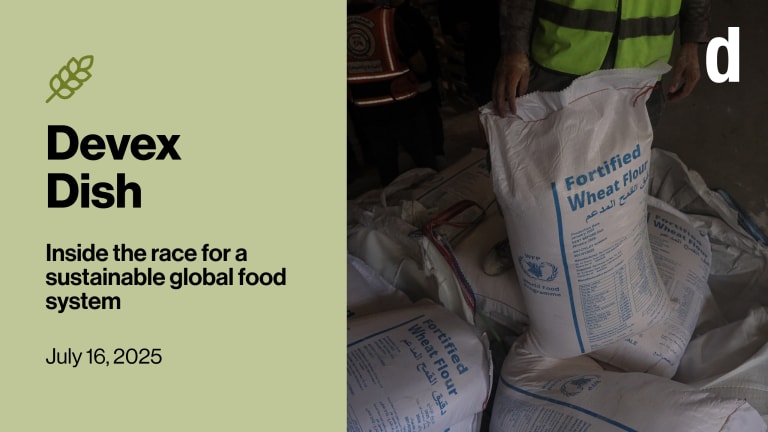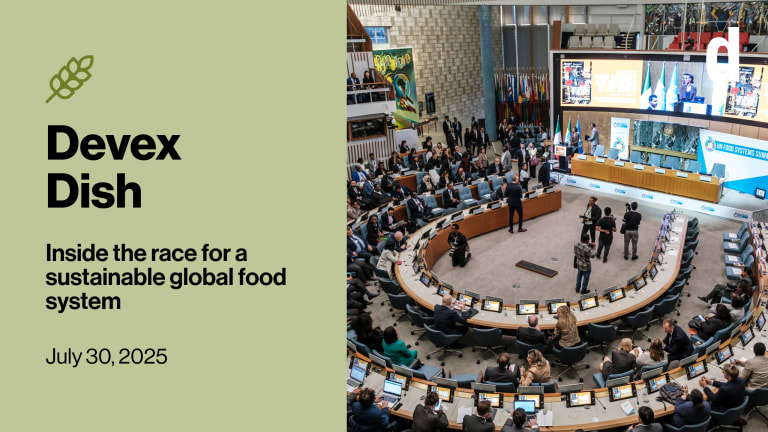
One of my most haunting memories from visiting a severe acute malnutrition center during the height of the last Horn of Africa drought wasn’t what I saw — it was what I didn’t hear.
The ward, deep inside Kenya’s Dadaab refugee camp on the Somali border, was full of infants and toddlers, yet it was almost silent. No cries, no wails — just a heavy, unnatural quiet. The children were too weak to make a sound. I spoke to distressed mothers, exhausted fathers, overstretched doctors and nurses. But that silence in a room filled with children stuck with me.
I’ve been thinking about that visit a lot lately as the U.S. government’s Famine Early Warning Systems Network, or FEWS NET — a global tool designed to detect these humanitarian crises before they escalate — is in freefall. USAID has pulled the plug on FEWS NET, the world’s most reliable food insecurity early warning system, which it had been running for 40 years. And its broader budget cuts to the humanitarian aid sector are now threatening the Integrated Food Security Phase Classification, or IPC, a global framework that assesses hunger severity and helps coordinate responses.
“At the time we’re pulling this plug, we’re also heading to a period in which the risk of multiple famines simultaneously at different points in the world is very high,” says Chris Newton, senior early warning analyst at the International Crisis Group.
Earlier this month, Chemonics, USAID’s key contracting partner in operating FEWS NET, was told that it could restart some of its work on the program, a source familiar with the matter tells Devex. But restarting isn’t as simple as flipping a switch. Chemonics is still waiting on at least $100 million in U.S. payments for work done, and budget constraints have forced it to lay off more than 60% of its U.S.-based staffers. And many of the partnerships that made FEWS NET function — such as those with the National Oceanic and Atmospheric Administration and NASA — are themselves facing budget cuts.
“Just because we know less doesn't mean the suffering is less,” Nicholas Haan, a famine expert who helped create IPC in 2004, tells me.
The challenges IPC faces are indirect but still concerning. IPC does not rely on USAID funding, but many of the NGOs that provide the data it depends on do — and those organizations are now scaling back or shutting down operations due to the U.S. aid freeze.
“Recent U.S. government funding cuts are impacting Action Against Hunger’s ability to support the IPC as fully as we would like,” says Eric Bebernitz, the organization’s director of external relations. “It seems likely that our ability to conduct field surveys also will be hampered, although we are still determining how far-reaching the effects will be.”
In a place like Sudan, the consequences of this lack of information could be dire and deadly. FEWS NET data is gone, the government suspended its participation in the IPC process, and even Médecins Sans Frontières has been forced to stop working in Zamzam camp in Darfur, where famine was declared last year, due to the escalation of fighting.
And now, the lean season in Sudan — already the worst time for food insecurity — is fast approaching. Without clear data on where hunger is hitting hardest, the world is stumbling into this critical period blind. The consequences could be catastrophic.
Read: After decades of progress, USAID cuts could blind the world to famine
Background: How is a famine declared?
And ICYMI: The Trump administration’s flip-flop on treating malnourished children (Pro)
+ Not yet a Devex Pro member? Start your 15-day free trial now to access the event as well as all our expert analyses, insider insights, funding data, and more. Check out all the exclusive content and events available to you.
See you in Paris
Well that came up fast: The big Nutrition for Growth Summit kicks off next week in Paris, France. Devex will be on the ground covering it, and we’d love to meet Dish readers. Got an event or tip to share? Drop Senior Editor Tania Karas a line at tania.karas@devex.com.
A new US humanitarian bureau?
By September, USAID could be replaced by a new humanitarian assistance bureau embedded in the U.S. State Department — one that would oversee food aid, among other things.
My tireless colleague Elissa Miolene scooped an exclusive look at how the agency’s dissolution is already being mapped out. In a closed-door meeting last week, Tim Meisburger, head of USAID’s Bureau for Humanitarian Assistance, reportedly outlined a plan to divide the new bureau into four offices: one for acquisitions and assistance, one for global disaster response, one for global health emergencies, and one for humanitarian and food assistance.
The office of humanitarian and food assistance would envelop programs at the State Department’s Bureau of Population, Refugees, and Migration. And USAID’s regional bureaus will be merged into the State Department’s foreign assistance offices, with hubs in Bangkok, Nairobi, Pretoria, and other locations taking on regional aid distribution.
Meisburger reportedly said the restructuring was about making “lemonade out of lemons,” according to meeting notes reviewed by Devex. But questions remain: How will food aid be handled under this new structure? Will it retain USAID’s expertise in emergency food distribution, or will bureaucratic reshuffling slow down response times? Crucially, what will funding levels look like? And does this mean anything for the proposals to move some of USAID’s food aid programming to the U.S. Department of Agriculture? Is there any hope for the longer-term food security work of USAID’s former Bureau for Resilience, Environment, and Food Security? (We hear agriculture programming will be fully discarded.)
The uncertainty over which programs will be cut and which will survive is only growing. Last week, the few remaining staff were ordered to review awards, even after thousands had already been canceled. In an effort to make their importance clear, staff stripped away development jargon, naming them as plainly as possible. But even projects with titles like “Lifesaving American Food Assistance for Starving Children in Ethiopia” received dismal scores — just 104 out of 180 — under the State Department’s new review playbook.
For now, the recipe for this lemonade is still being written — and whether it turns out sweet or too sour to swallow remains to be seen.
Exclusive: Inside the closed-door meeting on USAID’s future
ICYMI: As USAID is dismantled, Republicans fight to save a food aid program
More coverage on the U.S. aid cuts:
• This just in: Judge finds DOGE’s shutdown of USAID ‘likely’ unconstitutional.
• Democratic lawmakers push Rubio, Trump administration for USAID answers.
• With U.S. funding loss, WHO forced to make ‘terrible’ programmatic choices.
• Opinion: Don’t panic, history shows development orgs can survive budget cuts.
Number munching
3.3 million
—That’s how many lives U.S. assistance is estimated to save every year through programs in food aid, broader humanitarian relief, and efforts to fight HIV/AIDS, malaria, tuberculosis, and vaccine-preventable diseases, according to a study from the Center for Global Development.
Bringing home the bacon
Your next job?
Senior Director, Monitoring, Evaluation, Accountability, and Learning
Feed the Children
Africa | MENA | Washington, D.C., United States (remote)
Of that total, 549,100 lives — at a cost of $17,835 per life — are saved specifically through humanitarian assistance — a category that includes but isn’t limited to food aid. But even half a million lives a year is likely an underestimate, “both because humanitarian assistance provides considerably more than food and because the mapping from malnutrition to mortality is much steeper in many crisis situations,” CGD states.
And the impact goes beyond emergency relief. U.S. nutrition assistance, which tackles malnutrition both inside and outside of crisis settings, is also saving lives. Estimates suggest that targeted nutrition programs can prevent deaths at a cost of $1,600 to $4,300 per life saved. In 2020 alone, U.S. nutrition-specific funding of $309 million was estimated to avert between 71,000 and 193,000 deaths.
As USAID funding remains frozen and food aid programs stall, these lifesaving interventions are at risk — leaving many vulnerable.
Chew on this
The World Food Programme is cutting aid for 1 million people in Myanmar next month due to funding shortfalls. [Reuters]
Microplastics hinder plant photosynthesis, study finds, which could threaten 400 million more people with starvation in the next two decades. [The Guardian]
U.S. aid cuts cause uproar over food shortages in Kenyan refugee camp. [Devex]
A cross-party committee of members of Parliament is urging the U.K. government to pledge at least £50 million ($64.9 million) to the Child Nutrition Fund at next week’s Nutrition for Growth Summit. [UK Parliament]
Elissa Miolene contributed to this edition of Devex Dish.








